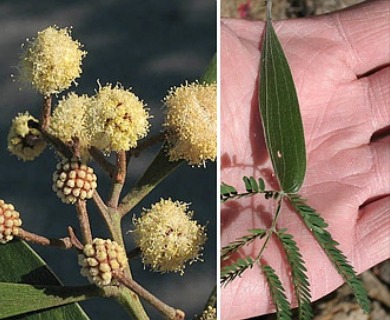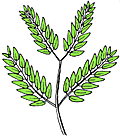Blackwood Acacia
Acacia melanoxylon
Pea family (Fabaceae)
Post-Cook introduction
Blackwood acacia, or Australian blackwood, is an tree introduced in forestry tests and as an ornamental. It differs from the native koa, Acacia koa, in that its “leaves” are shorter and less curved, and its pods are narrow and curved. Mimosa subfamily (Mimosoideae).

©2010 Anthony Valois and the National Park Service
Leaves modified as sickle-shaped flattened leaf-stalks or (phyllodes) narrowly sickle-shaped or lance-shaped, slightly curved, 2½–4½ inches (6–12 ) long and 3⁄8–3⁄4 inch (1–2 ) wide, thickened and leathery, hairless, long-pointed at both ends, with dot-like near almost stalkless base, with 3–6 fine parallel veins from base, dull green. Leaves of young plants (juvenile) are (), to 5 inches (13 ) long, with 4–10 pairs of branches, each with 15–20 pairs of oblong thin dull green 3⁄8–1⁄2 inch (10–13 ) by 1⁄8 inch (3 ).
Flower clusters () of 3–5 short-stalked light yellow balls (heads) 3⁄8–1⁄2 inch (10–13 ) in diameter at the leaf base. Flowers tiny, 30–50 stalkless in ball, consisting of cup-shaped 5- to 5 narrow petals united in lower part, many spreading thread like separate 1⁄4–5⁄16 inch (6–8 ) long, ending in dot and narrow with hairy one-celled and threadlike
(pods) are oblong, narrow, 3–5 inches (7.5–13 ) long and less than 3⁄8 inch (1 ) broad, flat with thick borders, reddish brown, curved and twisted. Seeds 6–10, beanlike elliptical, 3⁄16 inch (5 ) long, shiny black, hanging and encircled by red ringlike stalks.
The wood is golden brown to dark brown, sometimes tinged or streaked with red, with a beautiful figure very similar to koa. It is hard, moderately heavy, moderately strong and durable, works easily, turns well, and takes a high polish. The wood has been compared with black walnut, as has koa.
Known as blackwood or “hickory,” this species is one of the most ornamental Australian timbers, used principally for cabinet work, paneling, also veneer, split staves, and furniture. Wood of five trees grown at Kokee, Kauai, was tested in 1966 and found to be similar in density and appearance to koa, but with a somewhat higher shrinkage in drying.
Propagated from seed, also by root sprouts. Relatively slow growing. Elsewhere planted as a street tree and ornamental, though not recommended for Hawaii for these purposes because of the root suckering problem. Introduced also in California where it grows very well as a street tree. A total of 17,000 trees were planted in the Forest Reserves before 1960. Since 1960 several large plantings have been made in the Waiakea Forest Reserve on Hawaii, but the trees there are slow growing.
Special area
Kokee
Champion
Height 78 ft (23.8 ), c.b.h. 8.2 ft (2.5 ), spread 57 ft (17.4 ). Kokee State Park, Kauai (1968).
Range
Native of southeastern Australia
Other common names
Australia blackwood, blackwood, black acacia









